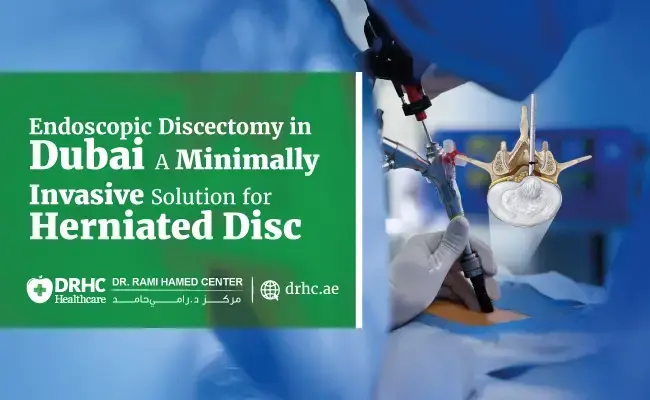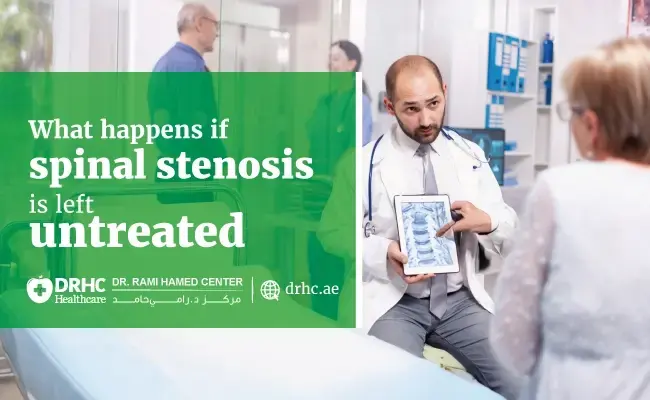
If you’ve been told you have cervical spondylosis and are experiencing symptoms like numbness, weakness, or difficulty with coordination, it can feel worrying, especially when you hear terms like spinal cord compression. At the Dr. Rami Hamed Center (DRHC) in Dubai, we understand how uncertain and overwhelming these symptoms can be. Our aim is to help you understand the condition, what causes spinal cord compression, and what treatment options are available to help you feel better and stay active.
What Is Cervical Spondylosis?
Cervical spondylosis is a common age-related condition that affects the neck (cervical spine). Over time, the discs and joints in the neck gradually wear down, similar to arthritis in other parts of the body. While many people with cervical spondylosis have no symptoms, others may develop pain, stiffness, or more serious neurological symptoms when spinal cord compression occurs.
How Cervical Spondylosis Leads to Spinal Cord Compression
Spinal cord compression happens when something narrows the space within the spinal canal, putting pressure on the spinal cord. In cervical spondylosis, this narrowing is usually caused by the following changes:
1. Degeneration of Discs and Joints
As we age, the discs between the vertebrae can lose water content and become less flexible. This makes them thinner and less able to cushion the bones, causing the vertebrae to move closer together and increasing the risk of compression.
2. Bone Spurs (Osteophytes)
The body often tries to compensate for the extra pressure on joints by forming bone spurs—bony growths that develop along the edges of the vertebrae. While these are intended to stabilize the spine, they can press on the spinal cord or nerve roots.
3. Thickened Ligaments
The ligamentum flavum, a ligament that runs along the spine, can thicken over time. This thickening can reduce the available space in the spinal canal, contributing to compression.
4. Herniated Discs
A disc weakened by age or injury may bulge or rupture, pushing into the spinal canal and pressing on the cord or nerves.
Recognizing the Symptoms of Spinal Cord Compression
When the spinal cord is compressed in the cervical spine, the symptoms may appear in various parts of the body, not just the neck.
Common symptoms include:
- Neck pain or stiffness
- Numbness or tingling in the arms or hands
- Weakness in the arms, hands, or legs
- Problems with balance or coordination
- Difficulty with fine motor skills (like buttoning a shirt)
- In severe cases, bladder or bowel issues
If you’re noticing these signs, especially if they’re getting worse, it's important not to delay seeking medical attention. Early diagnosis and treatment can prevent permanent nerve damage.
How Is Spinal Cord Compression Diagnosed?
At DRHC Dubai, we take a comprehensive approach to diagnosis. This typically includes:
- Clinical evaluation to assess symptoms, reflexes, and muscle strength
- MRI (Magnetic Resonance Imaging) to visualize the spinal cord, discs, and any compression
- CT scan or X-rays to assess bone changes and alignment
- Nerve studies, if needed, to assess how well electrical signals are traveling through the nerves
Our team will guide you through these steps with care, answering your questions and making sure you feel supported every step of the way.
What Are the Treatment Options?
We know that hearing the term “spinal cord compression” can sound alarming. But not all cases require surgery. Many patients benefit from a combination of nonsurgical treatments first.
Conservative Treatment Options:
- Medications for pain and inflammation
- Physical therapy to strengthen muscles and improve posture
- Neck bracing for short-term support
- Activity modifications to reduce strain
- Epidural steroid injections (in select cases) to reduce inflammation
When Is Surgery Recommended?
If conservative treatments fail or symptoms are progressing—especially if there's weakness or trouble with coordination—surgery may be necessary to relieve the pressure on the spinal cord.
At DRHC Dubai, our experienced spine surgeons use advanced, minimally invasive techniques whenever possible. This approach helps reduce recovery time, minimize pain, and lower the risk of complications.
Explore Our Related Blogs
- Who Is a Candidate for Minimally Invasive Spinal Surgery?
- How spine surgery relieves nerve compression and restores function
- How a herniated disc can lead to sciatica
- How spinal stenosis causes neurogenic claudication
FAQs: Your Questions Answered
1. Is spinal cord compression dangerous?
If left untreated, it can lead to permanent nerve damage, but early intervention often leads to excellent outcomes.
2. Will I need surgery right away?
Not necessarily. Many patients improve with conservative treatments. Surgery is considered when symptoms are severe or worsening.
3. How long is the recovery from surgery?
It depends on the procedure, but minimally invasive surgeries often allow patients to return to light activities within a few weeks.
4. Can I exercise with cervical spondylosis?
Yes, but it should be guided by a specialist. Physical therapy at DRHC can help you strengthen safely and avoid further compression.
5. Is spinal cord compression the same as a pinched nerve?
Not exactly. A pinched nerve affects a single nerve root, while spinal cord compression affects the entire spinal cord, which can lead to more widespread symptoms.
Support and Treatment Available at DRHC Dubai
If you or a loved one is experiencing symptoms of cervical spondylosis or spinal cord compression, know that you're not alone, and help is available. At Dr. Rami Hamed Center in Dubai, our multidisciplinary team is here to diagnose, treat, and guide you every step of the way, whether you need therapy, pain management, or surgery.
Book your consultation today and take the first step toward relief and recovery.
Dr. Rami Hamed
Consultant Spine & Orthopedic Surgeon
Founder, DRHC – Dubai Healthcare City
📞 +971 4 279 8800
🌐 www.drhc.ae
📍 Dubai Healthcare City, Building 52
Topic: orthopedic Spine Surgery




.jpg)




Leave a comment